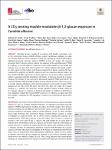A CO <sub>2</sub> sensing module modulates β-1,3-glucan exposure in <i>Candida albicans</i>
| dc.contributor.author | Avelar, GM | |
| dc.contributor.author | Pradhan, A | |
| dc.contributor.author | Ma, Q | |
| dc.contributor.author | Hickey, E | |
| dc.contributor.author | Leaves, I | |
| dc.contributor.author | Liddle, C | |
| dc.contributor.author | Rodriguez Rondon, AV | |
| dc.contributor.author | Kaune, A-K | |
| dc.contributor.author | Shaw, S | |
| dc.contributor.author | Maufrais, C | |
| dc.contributor.author | Sertour, N | |
| dc.contributor.author | Bain, JM | |
| dc.contributor.author | Larcombe, DE | |
| dc.contributor.author | de Assis, LJ | |
| dc.contributor.author | Netea, MG | |
| dc.contributor.author | Munro, CA | |
| dc.contributor.author | Childers, DS | |
| dc.contributor.author | Erwig, LP | |
| dc.contributor.author | Brown, GD | |
| dc.contributor.author | Gow, NAR | |
| dc.contributor.author | Bougnoux, M-E | |
| dc.contributor.author | d'Enfert, C | |
| dc.contributor.author | Brown, AJP | |
| dc.contributor.editor | Alspaugh JA | |
| dc.date.accessioned | 2024-02-27T13:29:01Z | |
| dc.date.available | 2024-02-27T13:29:01Z | |
| dc.date.issued | 2024-02-14 | |
| dc.identifier.issn | 2161-2129 | |
| dc.identifier.issn | 2150-7511 | |
| dc.identifier.uri | https://pearl.plymouth.ac.uk/handle/10026.1/22085 | |
| dc.description.abstract |
<jats:p> Our innate immune defenses have evolved to protect us against microbial infection in part via receptor-mediated detection of “pathogen-associated molecular patterns” (PAMPs) expressed by invading microbes, which then triggers their immune clearance. Despite this surveillance, many microbial species are able to colonize healthy, immune-competent individuals, without causing infection. To do so, these microbes must evade immunity. The commensal fungus <jats:italic>Candida albicans</jats:italic> exploits a variety of strategies to evade immunity, one of which involves reducing the exposure of a proinflammatory PAMP (β-1,3-glucan) at its cell surface. Most of the β-1,3-glucan is located in the inner layer of the <jats:italic>C. albicans</jats:italic> cell wall, hidden by an outer layer of mannan fibrils. Nevertheless, some β-1,3-glucan can become exposed at the fungal cell surface. However, in response to certain specific host signals, such as lactate or hypoxia, <jats:italic>C. albican</jats:italic> s activates an anticipatory protective response that decreases β-1,3-glucan exposure, thereby reducing the susceptibility of the fungus to impending innate immune attack. Here, we exploited the natural phenotypic variability of <jats:italic>C. albicans</jats:italic> clinical isolates to identify strains that do not display the response to β-1,3-glucan masking signals observed for the reference isolate, SC5314. Then, using genome-wide transcriptional profiling, we compared these non-responsive isolates with responsive controls to identify genes potentially involved in β-1,3-glucan masking. Mutational analysis of these genes revealed that a sensing module that was previously associated with CO <jats:sub>2</jats:sub> sensing also modulates β-1,3-glucan exposure in response to hypoxia and lactate in this major fungal pathogen of humans. </jats:p> | |
| dc.format.extent | e0189823- | |
| dc.format.medium | Print-Electronic | |
| dc.language | en | |
| dc.publisher | American Society for Microbiology | |
| dc.subject | Candida albicans | |
| dc.subject | pathogen-associated molecular patterns | |
| dc.subject | beta-glucan masking | |
| dc.subject | carbonic anhydrase | |
| dc.subject | NCE103 | |
| dc.subject | immune evasion | |
| dc.title | A CO <sub>2</sub> sensing module modulates β-1,3-glucan exposure in <i>Candida albicans</i> | |
| dc.type | journal-article | |
| dc.type | Article | |
| dc.type | Early Access | |
| plymouth.author-url | https://www.ncbi.nlm.nih.gov/pubmed/38259065 | |
| plymouth.issue | 2 | |
| plymouth.volume | 15 | |
| plymouth.publisher-url | http://dx.doi.org/10.1128/mbio.01898-23 | |
| plymouth.publication-status | Published | |
| plymouth.journal | mBio | |
| dc.identifier.doi | 10.1128/mbio.01898-23 | |
| plymouth.organisational-group | |Plymouth | |
| plymouth.organisational-group | |Plymouth|Faculty of Health | |
| plymouth.organisational-group | |Plymouth|REF 2021 Researchers by UoA | |
| plymouth.organisational-group | |Plymouth|Users by role | |
| plymouth.organisational-group | |Plymouth|Users by role|Academics | |
| plymouth.organisational-group | |Plymouth|REF 2021 Researchers by UoA|UoA01 Clinical Medicine | |
| plymouth.organisational-group | |Plymouth|Faculty of Health|Peninsula Medical School | |
| plymouth.organisational-group | |Plymouth|REF 2028 Researchers by UoA | |
| plymouth.organisational-group | |Plymouth|REF 2028 Researchers by UoA|UoA01 Clinical Medicine | |
| dc.publisher.place | United States | |
| dcterms.dateAccepted | 2023-12-11 | |
| dc.date.updated | 2024-02-27T13:29:01Z | |
| dc.rights.embargodate | 2024-2-29 | |
| dc.identifier.eissn | 2150-7511 | |
| rioxxterms.versionofrecord | 10.1128/mbio.01898-23 |


